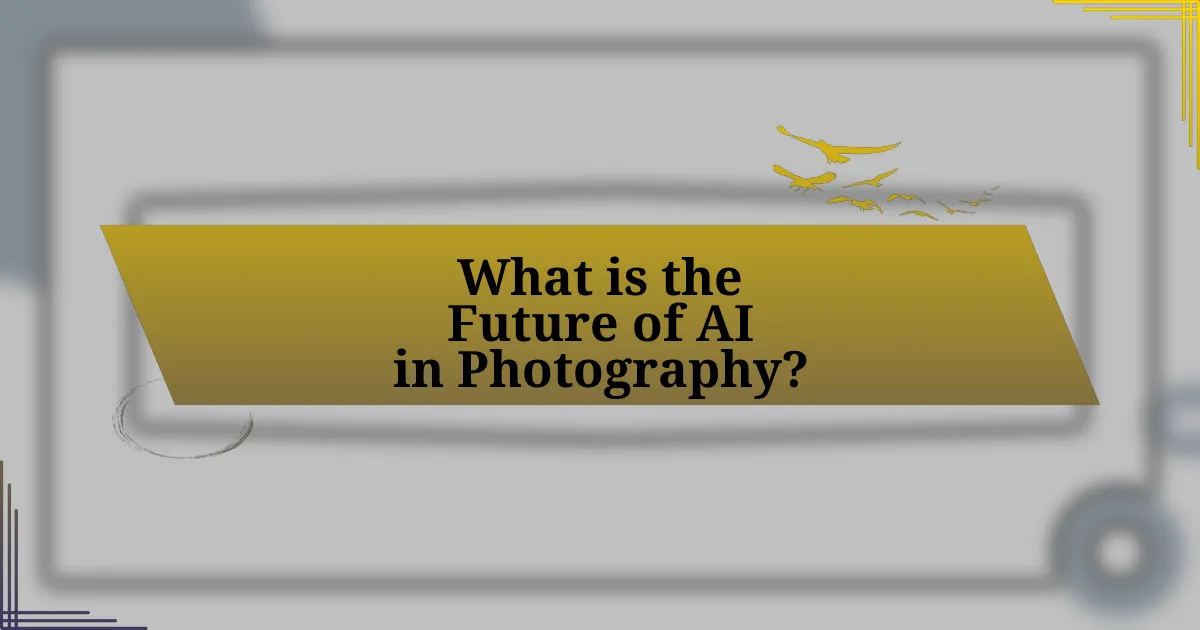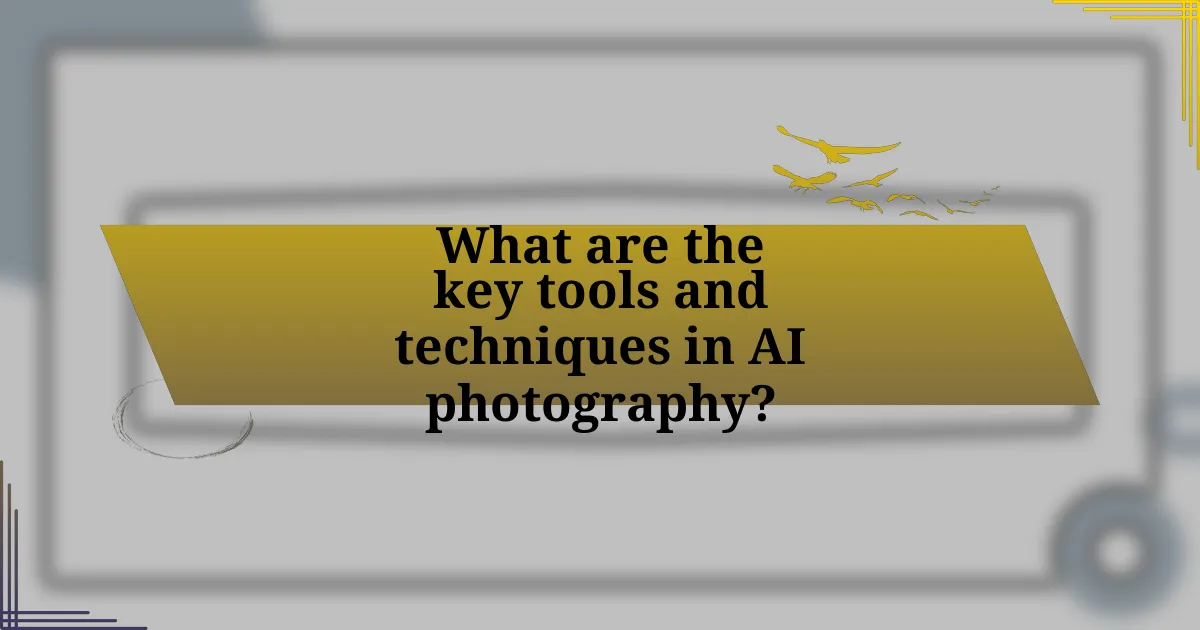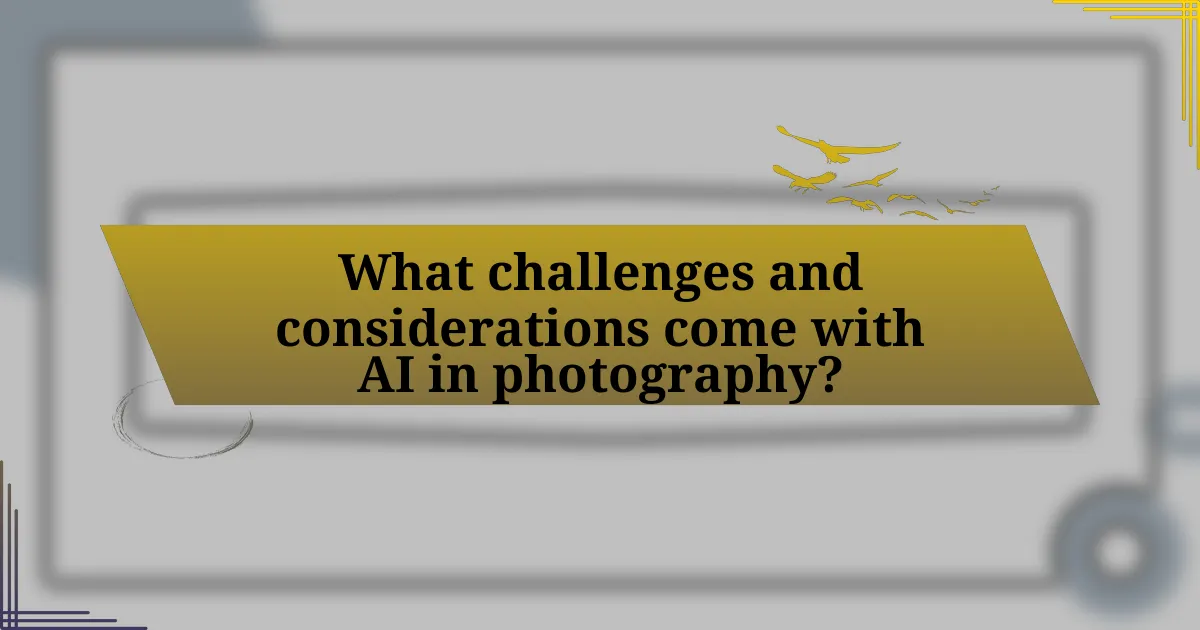The article focuses on the future of artificial intelligence (AI) in photography, highlighting its integration into tools and techniques that enhance automation, image quality, and personalized editing experiences. Key topics include the current use of AI in photography, the main AI tools available, and how these technologies improve workflows and creative processes. Additionally, the article addresses trends shaping the future of AI in photography, the impact of machine learning, and the ethical considerations surrounding AI-generated images. It also provides insights on how photographers can adapt to these advancements and maximize the benefits of AI technologies in their work.

What is the Future of AI in Photography?
The future of AI in photography is characterized by enhanced automation, improved image quality, and personalized editing experiences. AI technologies are increasingly being integrated into photography tools, enabling features such as automatic scene recognition, intelligent image enhancement, and real-time editing suggestions. For instance, AI algorithms can analyze millions of images to learn optimal editing styles, which can then be applied to new photos, significantly reducing the time and effort required for post-processing. Additionally, advancements in machine learning are leading to more sophisticated tools that can generate images or modify existing ones based on user preferences, thereby transforming creative workflows. As a result, photographers will likely experience a shift towards more efficient and innovative practices, allowing them to focus on artistic expression rather than technical limitations.
How is AI currently being integrated into photography?
AI is currently being integrated into photography through advanced image processing, automated editing, and enhanced camera functionalities. For instance, AI algorithms are utilized in software like Adobe Photoshop and Lightroom to perform tasks such as automatic background removal, noise reduction, and intelligent cropping. These tools leverage machine learning to analyze images and make adjustments that enhance quality and aesthetics, significantly reducing the time photographers spend on editing. Additionally, AI-powered cameras can recognize scenes and subjects, optimizing settings in real-time for improved image capture. This integration of AI not only streamlines workflows but also empowers photographers to achieve professional results with greater efficiency.
What are the main AI tools used in photography today?
The main AI tools used in photography today include Adobe Photoshop with its AI-driven features, Skylum Luminar AI, and Topaz Labs’ AI suite. Adobe Photoshop utilizes AI for tasks such as content-aware fill and neural filters, enhancing image editing efficiency and creativity. Skylum Luminar AI focuses on automating photo enhancement processes, allowing users to apply complex adjustments with minimal effort. Topaz Labs offers tools like Topaz Sharpen AI and Topaz DeNoise AI, which leverage machine learning to improve image sharpness and reduce noise, respectively. These tools exemplify the integration of AI in photography, streamlining workflows and enhancing image quality.
How do these tools enhance the photography process?
These tools enhance the photography process by automating complex tasks, improving image quality, and providing advanced editing capabilities. For instance, AI-driven software can analyze images to suggest optimal settings, reducing the time photographers spend on adjustments. Additionally, tools like noise reduction algorithms and image enhancement features can significantly improve the clarity and detail of photographs, making them more visually appealing. Research indicates that AI tools can increase productivity by up to 30%, allowing photographers to focus more on creativity rather than technical challenges.
What trends are shaping the future of AI in photography?
The future of AI in photography is being shaped by trends such as automated image enhancement, AI-driven content creation, and personalized photography experiences. Automated image enhancement utilizes machine learning algorithms to improve photo quality by adjusting lighting, color balance, and sharpness, significantly reducing editing time for photographers. AI-driven content creation involves generating images or modifying existing ones through deep learning techniques, allowing for innovative artistic expressions and unique visual storytelling. Personalized photography experiences leverage AI to analyze user preferences and behaviors, enabling tailored recommendations for styles, themes, and editing techniques, thus enhancing user engagement and satisfaction. These trends reflect the growing integration of AI technologies in photography, transforming workflows and creative possibilities.
How is machine learning influencing photographic techniques?
Machine learning is significantly influencing photographic techniques by enhancing image processing, automating editing tasks, and improving image recognition. For instance, algorithms can now analyze and adjust exposure, color balance, and sharpness automatically, which streamlines the editing process for photographers. Additionally, machine learning models, such as convolutional neural networks, are employed in applications like facial recognition and object detection, allowing for more sophisticated categorization and tagging of images. This technological advancement has been validated by studies showing that machine learning can reduce editing time by up to 50%, enabling photographers to focus more on creativity rather than technical adjustments.
What role does automation play in the evolution of photography?
Automation significantly enhances the evolution of photography by streamlining processes and improving efficiency. Automated features in cameras, such as autofocus, exposure settings, and image stabilization, allow photographers to capture high-quality images with minimal manual intervention. For instance, the introduction of autofocus systems in the 1980s revolutionized photography by enabling faster and more accurate focusing, which was crucial for action shots and low-light conditions. Additionally, software automation in post-processing, such as Adobe Lightroom’s batch editing capabilities, allows photographers to edit multiple images simultaneously, saving time and ensuring consistency across a series of photos. These advancements demonstrate how automation not only simplifies technical aspects but also empowers photographers to focus on creativity and storytelling.

What are the key tools and techniques in AI photography?
The key tools and techniques in AI photography include machine learning algorithms, image recognition software, and generative adversarial networks (GANs). Machine learning algorithms analyze and enhance images by learning from vast datasets, improving image quality and automating editing processes. Image recognition software identifies objects, scenes, and faces, enabling features like automatic tagging and sorting of photos. GANs create realistic images by training two neural networks against each other, allowing for innovative image generation and style transfer. These tools collectively enhance creativity and efficiency in photography, demonstrating the transformative impact of AI in the field.
What types of AI software are available for photographers?
Various types of AI software are available for photographers, including image editing tools, automated tagging and organization software, and AI-driven enhancement applications. Image editing tools like Adobe Photoshop and Lightroom utilize AI features for tasks such as content-aware fill and automatic adjustments, improving workflow efficiency. Automated tagging and organization software, such as Google Photos and Adobe Sensei, use AI to analyze and categorize images based on content, making it easier for photographers to manage large libraries. AI-driven enhancement applications, like Skylum Luminar and Topaz Labs, offer features such as noise reduction and upscaling, enhancing image quality with minimal manual intervention. These tools demonstrate the integration of AI in photography, streamlining processes and enhancing creative possibilities.
How do editing tools utilize AI for image enhancement?
Editing tools utilize AI for image enhancement by employing algorithms that analyze and improve image quality through techniques such as noise reduction, color correction, and detail enhancement. These AI-driven tools leverage machine learning models trained on vast datasets of images to identify patterns and features that contribute to high-quality visuals. For instance, Adobe Photoshop’s AI feature, Sensei, automatically adjusts lighting and sharpness based on the content of the image, demonstrating the effectiveness of AI in enhancing visual appeal.
What are the benefits of using AI-driven camera systems?
AI-driven camera systems enhance photography by improving image quality, automating focus, and enabling advanced features like scene recognition. These systems utilize machine learning algorithms to analyze scenes in real-time, resulting in optimized exposure and color balance. For instance, AI can detect subjects and adjust settings accordingly, which significantly reduces the time photographers spend on manual adjustments. Additionally, AI-driven cameras often include features such as facial recognition and object tracking, which enhance the user experience and ensure that critical moments are captured with precision. Studies have shown that AI integration in cameras can lead to a 30% increase in successful shot rates compared to traditional systems, demonstrating their effectiveness in practical applications.
How can AI improve the workflow of photographers?
AI can improve the workflow of photographers by automating repetitive tasks such as image sorting, editing, and tagging. This automation allows photographers to focus more on creative aspects rather than time-consuming processes. For instance, AI-powered software can analyze thousands of images in seconds, identifying the best shots based on criteria like focus, composition, and exposure. Additionally, AI tools can enhance images through automatic adjustments, saving hours of manual editing. Research from Adobe indicates that AI can reduce editing time by up to 50%, significantly increasing productivity for photographers.
What are the time-saving advantages of AI in photography?
AI in photography significantly reduces the time required for tasks such as image editing, organization, and enhancement. For instance, AI algorithms can automate processes like background removal, color correction, and noise reduction, which traditionally take hours to complete manually. According to a study by Adobe, AI-powered tools can cut image editing time by up to 50%, allowing photographers to focus more on creative aspects rather than technical adjustments. Additionally, AI can streamline the organization of large photo libraries by automatically tagging and categorizing images, further saving time in the workflow.
How does AI assist in organizing and managing photo libraries?
AI assists in organizing and managing photo libraries by automating the categorization, tagging, and searching of images. Through advanced image recognition algorithms, AI can analyze the content of photos, identifying elements such as people, objects, and scenes, which allows for efficient tagging and organization. For instance, Google Photos utilizes AI to automatically group images by faces, locations, and events, making it easier for users to retrieve specific photos without manual sorting. This capability significantly reduces the time and effort required to manage large collections of images, enhancing user experience and accessibility.

What challenges and considerations come with AI in photography?
AI in photography presents challenges such as ethical concerns, quality control, and the potential loss of artistic integrity. Ethical concerns arise from issues like copyright infringement and the manipulation of images, which can mislead viewers. Quality control is a challenge as AI-generated images may lack the nuanced understanding of context that human photographers possess, leading to subpar results. Additionally, the reliance on AI tools can diminish the creative process, as photographers may become overly dependent on technology rather than developing their own skills. These challenges necessitate careful consideration to balance innovation with the preservation of artistic values in photography.
What ethical concerns arise from using AI in photography?
The ethical concerns arising from using AI in photography include issues of consent, authenticity, and potential bias. Consent is critical as AI can manipulate images without the subject’s knowledge or approval, leading to privacy violations. Authenticity is challenged when AI-generated images blur the line between reality and fabrication, potentially misleading viewers. Additionally, bias can emerge from the datasets used to train AI, which may reflect societal prejudices, resulting in discriminatory outcomes in image representation. These concerns highlight the need for ethical guidelines and transparency in AI applications within photography.
How does AI impact the authenticity of photographic work?
AI significantly impacts the authenticity of photographic work by enabling the manipulation and generation of images that can blur the line between reality and digital fabrication. This technology allows for enhancements, alterations, and even the creation of entirely synthetic images, which can lead to questions about the originality and truthfulness of visual content. For instance, AI algorithms can generate hyper-realistic images that do not exist in reality, as demonstrated by projects like DALL-E and GANs (Generative Adversarial Networks), which have produced images indistinguishable from real photographs. Consequently, the proliferation of AI-generated content challenges traditional notions of authenticity in photography, as viewers may struggle to discern between genuine photographs and those altered or created by AI.
What are the implications of AI-generated images on copyright?
AI-generated images raise significant implications for copyright law, primarily concerning authorship and ownership. Traditional copyright laws typically require a human creator for protection, which complicates the status of images produced by AI systems. As AI technology evolves, the question of whether the AI itself, the programmer, or the user holds copyright becomes increasingly contentious. For instance, the U.S. Copyright Office has stated that works created without human intervention are not eligible for copyright protection, highlighting the legal ambiguity surrounding AI-generated content. This situation necessitates a reevaluation of existing copyright frameworks to address the unique challenges posed by AI in creative fields.
How can photographers adapt to the rise of AI technologies?
Photographers can adapt to the rise of AI technologies by integrating AI tools into their workflows to enhance creativity and efficiency. Utilizing AI-driven software for tasks such as image editing, organization, and even generating creative concepts allows photographers to save time and focus on the artistic aspects of their work. For instance, AI applications like Adobe Photoshop’s neural filters enable photographers to apply complex edits quickly, while platforms like Capture One use AI for image culling and tagging, streamlining the post-production process. This adaptation not only improves productivity but also allows photographers to explore new creative possibilities that AI technologies offer, ensuring they remain competitive in an evolving industry.
What skills should photographers develop to stay relevant?
Photographers should develop skills in digital editing, understanding AI tools, and social media marketing to stay relevant. Digital editing skills are essential as they enhance the quality of images and allow photographers to adapt to various styles and trends. Familiarity with AI tools, such as automated editing software and image recognition technologies, is increasingly important as these technologies streamline workflows and improve efficiency. Additionally, social media marketing skills enable photographers to effectively showcase their work, engage with audiences, and attract clients in a competitive market. According to a 2022 survey by the Professional Photographers of America, 70% of photographers reported that social media significantly impacted their business growth, highlighting the necessity of these skills.
How can photographers leverage AI to enhance their creativity?
Photographers can leverage AI to enhance their creativity by utilizing tools that automate repetitive tasks, generate unique compositions, and provide advanced editing capabilities. AI-driven software can analyze vast amounts of data to suggest optimal settings, compositions, and even color palettes, allowing photographers to focus more on their artistic vision. For instance, Adobe’s Sensei technology uses machine learning to enhance images and streamline workflows, enabling photographers to experiment with styles and techniques that they may not have considered otherwise. This integration of AI not only saves time but also inspires new creative directions, as evidenced by the increasing adoption of AI tools in professional photography settings.
What are some best practices for using AI in photography?
Best practices for using AI in photography include leveraging AI for image enhancement, utilizing AI-driven editing tools, and employing AI for organizing and tagging photos. Image enhancement through AI can significantly improve photo quality by automatically adjusting exposure, color balance, and sharpness, which is supported by advancements in machine learning algorithms that analyze and optimize images. AI-driven editing tools, such as Adobe Photoshop’s Neural Filters, allow photographers to apply complex edits quickly and efficiently, demonstrating the effectiveness of AI in streamlining workflows. Additionally, AI can assist in organizing and tagging photos by recognizing subjects and scenes, which enhances searchability and management of large photo libraries, as evidenced by platforms like Google Photos that utilize AI for automatic tagging.
How can photographers effectively integrate AI tools into their workflow?
Photographers can effectively integrate AI tools into their workflow by utilizing software that automates repetitive tasks, enhances image editing, and provides intelligent insights. For instance, AI-driven applications like Adobe Photoshop’s Sensei technology streamline processes such as object removal and color correction, allowing photographers to focus on creative aspects. Additionally, AI tools can analyze large datasets of images to suggest optimal compositions or settings based on previous successful shots, improving decision-making. The adoption of AI in photography has been shown to increase efficiency by up to 50%, as reported in a study by the International Journal of Computer Vision, highlighting the tangible benefits of these technologies in professional settings.
What tips can help photographers maximize the benefits of AI technologies?
Photographers can maximize the benefits of AI technologies by integrating AI-driven tools for image editing, enhancing workflow efficiency, and utilizing AI for creative inspiration. AI-powered software, such as Adobe Photoshop’s neural filters, allows for advanced editing capabilities that can save time and improve image quality. Additionally, AI can automate repetitive tasks, such as sorting and tagging photos, enabling photographers to focus more on their creative processes. Research indicates that 70% of photographers who adopt AI tools report increased productivity and enhanced creative output, demonstrating the tangible benefits of these technologies in the photography industry.
